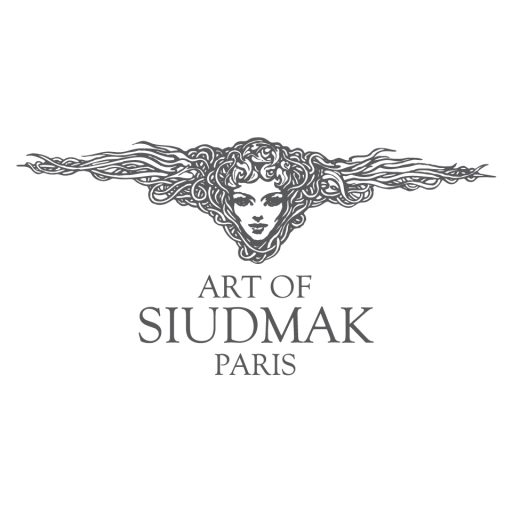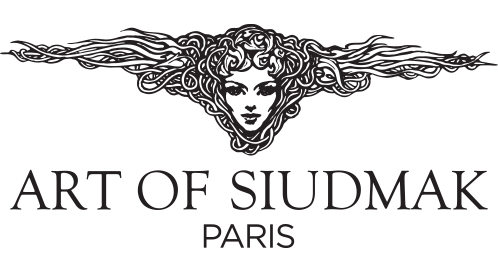“Creating is a series of unique moments. The idea for a painting appears suddenly like a flash of lightning across the darkness of a black sky. The hand records this fleeting moment with an outline, so simple that it resembles an embryo, or perhaps a symbol from Chinese or Japanese script. Then comes a series of drawings, as if tracing the stages of the development of a foetus. As the painting materialises, there must be no doubt: it is not a question of a living being but an object in all its modesty. So why does this image suddenly appear? Why does it want to exist? From which short circuit does the energy which sparks off an idea flow? These questions do not necessarily lead to answers. In the face of this mystery, one can always lift up a corner of the veil, but perhaps it is better and more enlivening to contemplate the fruit of this creative energy”.
These remarks of Siudmak relate, in the author’s own words, the experience of creation which is at one and the same time inexpressible and yet so often talked about. The key word is without doubt modesty; paradoxical in a visionary artist whose paintings represent another world, rival to ours. In a case like this, the artist is easily tempted to allow himself to be submerged by the richness deep within him; the line between this and believing himself to be a seer is very fine, occasionally crossed by the greatest. For Siudmak it is the complete opposite: he minimises the role played by the eye, foregrounding facing the unknown and stressing the importance of the hand which transcribes and tirelessly conveys an energy which comes from one knows not where.
Siudmak reduces the paradox by proclaiming loud and clear that he represents not another world, but our own. “The strange intermingling of loves and destinies, successes and catastrophes, admiration and scorn; situations of which life offers an infinite range. It is like an opened fan which suddenly shows me reality and dreams, the rainbow and the storm, happiness and grief, faces and bodies in their extraordinary vibrancy. It is particularly reassuring”.
It must be added that Siudmak is a man of the twentieth century and a witness of his time. Technological creativity is not a source of anxiety for him but the promise of extra riches, a widening of horizons, an indefinable upsurge of new surprises. Our world? Perhaps. But painted with a fervour which irresistibly evokes the wonders of surrealism.
“It is fortunate to be an unpretentious and patient scribe, who from morning to night untiringly records this enormous and fascinating book of life, of which we are only passing witnesses, insignificant and unimportant. How pretentious to believe that our pictures will leave their marks for those who follow. We are merely doing our task, simply and arduously, with the simplicity of daily efforts and with the joys and sorrows resulting from the failures or successes that each working day brings. It is a source of happiness as powerful as a loved one’s smile or the infinite gentleness of a child”.
Siudmak’s modesty goes as far as asserting banality, which will undoubtedly astound most of his admirers. “I feel”, he says, “a sense of poverty when looking at nature. Whatever we might do to find more original or richer forms, nature always surpasses us”. He himself is astonished by his own exaltation in the effort, where he is close to seeing blindness. The painter’s joy is the present; but future will not confirm it.
Finally, Siudmak has the pride of his modesty. In refusing all intellectualisation, all demiurgic ambition and any sacred halo, he dismisses a large part of modern art and its Promethean wrath. He adds, “The creator is alone facing his work. Literary or philosophical support made fast to a canvas gives it no extra value. The sumptuous wreaths woven by shrewd critics wilt immediately unless they are constantly watered by the living source of the painter’s inspiration”. On this subject, one can read his elaboration on abstract art, which he rejects after having been through it himself. In contrast i s hyperrealism, which he has c learly understood has made him, “aware of our enormous technical abilities, equal or superior to that of photography”. Not that he cultivates the fine detail for its own strangeness: the only justification for using the ‘tricks of the trade’ is that they enable the painter to fulfil his unique mission: to depict the world as it is.
In this field, nothing is equal to the classics, the Mozarts of painting. “I am fascinated by the virtuosity of Tiepolo, not in his frescoes but in his paintings. What a divine talent! Matter, flesh, gestures, sentiments and light are portrayed by almost nonchalant strokes. With a little colour at the tip of his brush in a unique and marvellous gesture, he leaves an almost living trace. I admire the same, though slightly more laborious, divine creativity of Ribera’s work”.
Thus the present gesture of the painter holds enough fervour to allow him to forget the future, but fervour cannot be achieved without skills and above all without the fervour of skill, which implies a memory of the past. Dal. had already borrowed from Bracelli, a Tuscan painter of the seventeenth century, the idea of putting drawers in the Venus de Milo. Siudmak, taking up the idea, does not refer back to Dal. (although he has never hidden his debt to this painter) but to Bracelli. To return to nature is also to return to the origins, like all true classicists.

Jacques Goimard
From Wikipedia, the free encyclopedia

